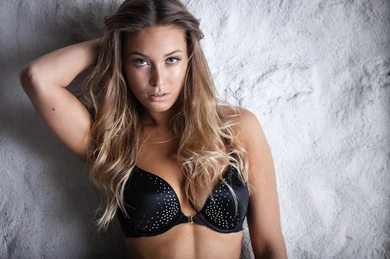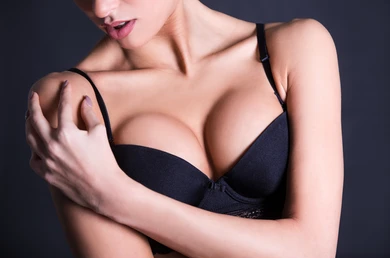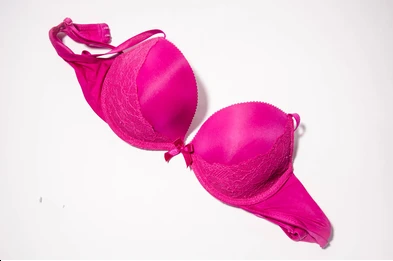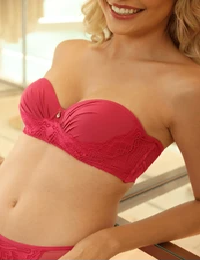Designing and crafting the perfect bra requires a combination of artistry, technical expertise, and a deep understanding of the female form. From selecting high-quality materials to ensuring a comfortable fit and optimal support, creating a bra that meets the needs and desires of women is a meticulous process. In this article, we will explore the steps involved in making a perfect topwear bra and the key considerations that go into its creation.
Understanding the Female Form about Perfect Bra
Understanding the female form is fundamental in creating a perfect bra that fits well, offers comfort, and enhances the natural shape of a woman’s breasts. Here are some key aspects to consider when it comes to understanding the female form in the context of bra design:
1. Breast Shape and Size:
Breasts come in various shapes and sizes, including round, teardrop, asymmetrical, shallow, or full. Recognizing the diversity of breast shapes allows designers to develop bras that cater to different proportions, providing optimal support and a flattering fit.
2. Band and Cup Sizes:
The band size represents the measurement around the ribcage, while the cup size relates to the breast volume. Understanding the correlation between band and cup sizes is essential for creating bras that accommodate a wide range of body types and ensure a proper fit.
3. Breast Position:
Breast position can vary among individuals, with some breasts sitting higher on the chest wall while others are lower. Designers need to consider breast placement when determining strap length, underwire shape, and cup placement to achieve adequate lift and support.
4. Support Needs:
Different breasts have different support needs. Some may require more lift, while others may need enhanced shaping or minimizing effects. Understanding these support needs helps in incorporating the appropriate features, such as underwires, padded cups, or strategic seaming, to provide the desired level of support.
5. Body Proportions:
Consideration of overall body proportions is essential in bra design. The size, shape, and positioning of the breasts should harmonize with the individual’s body frame, taking into account factors such as shoulder width, torso length, and waist-to-hip ratio.
6. Comfort and Movement:
A well-designed bra should allow for comfortable movement throughout the day. Understanding how the body moves and the range of motion required ensures that the bra’s construction and materials allow for freedom of movement without sacrificing support or comfort.
7. Individual Preferences:
Every woman has her own preferences when it comes to fit, coverage, and style. Understanding individual preferences, such as preferred levels of padding, wire-free options, or specific design details, allows for the creation of perfect bras that cater to diverse tastes and needs.
By considering these aspects and embracing the diversity of the female form, designers can create bras that celebrate and enhance the natural beauty and uniqueness of each woman’s body. Understanding the female form is at the core of bra-making, enabling the creation of bras that provide optimal support, comfort, and confidence.
Research and Design about Perfect Bra
Research and design are integral parts of the process of creating a perfect Topwear bra. They involve gathering insights, exploring trends, and translating them into innovative and functional designs. Here are the key steps involved in the research and design phase of perfect bra-making:
1. Market Research:
Conducting market research helps designers understand current trends, customer preferences, and emerging needs in the lingerie industry. This involves analyzing consumer behavior, studying competitor offerings, and identifying gaps or opportunities in the market.
2. Customer Insights:
Gathering insights from customers through surveys, focus groups, or feedback helps designers understand their needs, desires, and pain points related to perfect bras. This information guides the design process, ensuring that the bras address specific customer concerns and preferences.
3. Trend Analysis:
Staying abreast of fashion, design, and lingerie trends is crucial in creating bras that are both stylish and functional. Designers research fashion runways, trade shows, industry publications, and online platforms to identify emerging styles, color palettes, and fabric choices.
4. Material Exploration:
Exploring different materials is an essential aspect of perfect bra design. Designers research and test various fabrics, elastics, laces, and trims to identify those that offer the desired comfort, support, and aesthetic qualities. Considerations include breathability, stretch, durability, and hypoallergenic properties.
5. Sketching and Concept Development:
Based on the gathered insights, trends, and material exploration, designers create initial sketches and concepts for the bra designs. This stage allows for creativity, experimentation, and the exploration of different shapes, silhouettes, and details.
6. Prototyping:
Prototyping involves translating the initial design concepts into physical samples. Designers work closely with pattern makers and sample makers to create prototypes that capture the desired fit, shape, and construction details. Multiple iterations may be required to refine the design.
7. Fit Testing and Iteration:
Fit testing is crucial to ensure that the perfect bra design meets the desired fit and comfort standards. Samples are tried on different models or fit testers to evaluate the fit, adjust patterns if necessary, and make improvements based on feedback.
8. Technical Drawings and Specifications:
Detailed technical drawings and specifications are created to communicate the design details, construction methods, measurements, and materials to the production team. These documents serve as a guide for the manufacturing process.
9. Collaboration with Production Team:
Designers work closely with the production team, including pattern makers, sample makers, and technicians, to ensure that the design vision is translated accurately into the final product. Collaboration and clear communication are vital to maintain design integrity during production.
10. Documentation and Design Files:
Proper documentation of design files, technical drawings, and specifications is important for future reference and to maintain consistency in subsequent production runs or design updates.
Research and design lay the foundation for creating perfect bras that are not only aesthetically pleasing but also functional and aligned with customer needs. By conducting thorough research, gathering customer insights, and employing innovative design techniques, designers can develop bras that offer comfort, support, and style, ultimately leading to the creation of a perfect bra.
Material Selection for Perfect Bra
Selecting the right materials is a crucial step in the perfect bra-making process. The chosen materials play a significant role in determining the comfort, support, durability, and aesthetic appeal of the final product. Here are some key considerations for material selection in bra-making:
1. Comfort and Breathability:
Bras are worn close to the skin, so selecting materials that are comfortable and breathable is essential. Fabrics like cotton, bamboo, or microfiber are known for their breathability, moisture-wicking properties, and softness against the skin. These materials help prevent irritation, itching, and excessive sweating.
2. Stretch and Support:
Bras require a balance of stretch and support to provide a comfortable fit and proper breast support. Materials with a degree of stretch, such as spandex or elastane blended with other fibers, allow the bra to contour to the body while providing support and shape retention.
3. Stability and Structure:
Certain components of bras, such as the cups, underwire channels, and bands, require materials with stability and structure. Fabrics like power mesh or non-stretch fabrics are used to provide stability, shape, and support to these areas. These materials help maintain the bra’s structure and prevent excessive stretching.
4. Moisture Management:
Moisture management is important in bras, particularly for active or sports bras. Fabrics with moisture-wicking properties, such as performance blends or technical fabrics like polyester or nylon, help to draw moisture away from the skin, keeping the wearer dry and comfortable during physical activities.
5. Aesthetic Appeal:
The visual appeal of a bra is influenced by the choice of materials. Lace, satin, silk, or other decorative fabrics add a luxurious and feminine touch, enhancing the overall aesthetic appeal of the perfect bra. Trims and embellishments, such as ribbons, bows, or embroidery, can also be incorporated to add style and detail.
6. Durability and Longevity:
Selecting durable materials is important to ensure that the bras withstand regular wear and washing. Fabrics with good colorfastness, resistance to pilling, and high-quality elastic components contribute to the longevity of the bra. Reinforcing materials like strong threads and sturdy hardware also enhance the durability of the garment.
7. Skin Sensitivity:
Some individuals may have skin sensitivities or allergies to certain materials. It is important to consider hypoallergenic or skin-friendly fabrics when designing bras to minimize potential skin irritations. Natural fibers like organic cotton or bamboo may be suitable options for those with sensitive skin.
8. Environmental Considerations:
Increasingly, sustainability and eco-friendliness are important factors in material selection. Designers may opt for organic or recycled materials, or choose fabrics produced through eco-friendly processes, reducing the environmental impact of the bras.
It is essential for designers to carefully evaluate and test different materials to ensure they meet the desired criteria of comfort, support, durability, and aesthetics. Considerations should align with the brand’s values, target market preferences, and the specific requirements of each bra design. By selecting the right materials, designers can create bras that not only look beautiful but also offer optimal comfort and support to the wearer.
Pattern Making about Perfect Bra
Pattern making is a crucial step in the bra-making process that involves creating a blueprint or template for cutting and sewing the bra components. It is an essential skill that ensures accuracy, fit, and consistency in bra production. Here are the key steps involved in pattern making for bras:
1. Measurements and Sizing:
Accurate measurements are taken to determine the size and proportions of the perfect bra. Measurements typically include underbust, overbust, and cup size. These measurements serve as a basis for creating the bra pattern.
2. Block Pattern Development:
A block pattern, also known as a sloper, is a basic template that serves as the foundation for creating different bra styles. The block pattern consists of the basic bra shape without any style details or variations. It is developed based on standard measurements and can be modified to create different cup shapes, strap widths, or band lengths.
3. Style Adaptation:
Once the block pattern is established, it is adapted to create different bra styles. This involves making modifications to the block pattern, such as adding or altering cup seams, adjusting strap placement, or shaping the underwire channel. These adaptations allow for the creation of various bra designs while maintaining a consistent fit and proportion.
4. Grading:
Grading involves scaling the pattern to create different sizes. This is done by systematically increasing or decreasing the dimensions of the pattern pieces according to size specifications. Grading ensures that the bra design can be produced in a range of sizes while maintaining the original design integrity.
5. Drafting and Truing:
Drafting refers to transferring the pattern from the initial block onto pattern paper or digital software. This involves drawing and connecting lines to create the various pattern pieces, such as cups, wings, and straps. Truing is the process of refining and smoothing the pattern lines, ensuring that they are symmetrical, smooth, and accurately aligned.
6. Adding Seam Allowance:
Seam allowance is added to the pattern to account for the sewing process. The amount of seam allowance may vary depending on the construction techniques used and the specific requirements of the bra design.
7. Mock-Up and Fitting:
A mock-up, also known as a toile, is a prototype made from inexpensive fabric. It is sewn using the pattern to evaluate the fit and make any necessary adjustments. Fitting the mock-up on a fit model or mannequin allows for fine-tuning the pattern and resolving any fit issues before cutting the final fabric.
8. Finalizing the Pattern:
Based on the fitting adjustments made during the mock-up stage, the pattern is refined and finalized. This includes making any necessary modifications to achieve the desired fit, comfort, and aesthetic appeal.
9. Digitization (Optional):
In modern bra-making, patterns can be digitized using computer-aided design (CAD) software. This allows for easier storage, modification, and scaling of the pattern, as well as digital communication with manufacturers.
Pattern making is a specialized skill that requires attention to detail, precision, and an understanding of how fabric, construction, and body shape interact. By creating accurate and well-fitting patterns, designers can ensure that their bra designs translate into comfortable and supportive garments that meet the needs and preferences of their customers.
Cutting and Sewing
Cutting and sewing for perfect bra are essential steps in the bra-making process that involve transforming the pattern into a finished garment. These stages require precision, attention to detail, and knowledge of sewing techniques. Here are the key steps involved in cutting and sewing a bra for perfect bra:
1. Fabric Preparation:
Before cutting the fabric, it is important to prepare it properly. This may involve pre-washing the fabric to prevent shrinkage and removing any wrinkles or creases. Fabrics should be handled carefully to avoid stretching or distorting the material.
2. Pattern Placement:
The pattern pieces are carefully placed on the fabric according to the cutting layout. Attention is paid to the fabric grain, pattern direction, and any specific design details that need to be aligned. Pattern weights or pins can be used to secure the pattern pieces in place.
3. Cutting:
Using sharp fabric scissors or a rotary cutter, the pattern pieces are cut out from the fabric. It is crucial to follow the cutting lines precisely to ensure accurate dimensions and maintain the integrity of the design. Seam allowances and any notches or markings on the pattern are also transferred onto the fabric.
4. Marking and Trimming:
Notches, darts, and other markings on the fabric are transferred from the pattern to facilitate accurate sewing and assembly. Trimming excess fabric from seam allowances may also be required, depending on the specific bra design.
5. Sewing Techniques:
Various sewing techniques are employed to construct the bra. This may include using different types of stitches, such as straight stitches, zigzag stitches, or stretch stitches, depending on the fabric and construction requirements. Techniques like sewing darts, attaching elastic, and creating gathers or pleats are utilized to shape the bra and provide support.
6. Seam Finishes:
Seam finishes help prevent fraying and give the garment a professional look. Depending on the fabric and design, seam finishes can include techniques like serging, zigzag stitching, French seams, or using bias binding.
7. Attachment of Hardware and Components:
Bra hardware, such as hooks and eyes, rings, sliders, and underwires, are attached during the sewing process. Care is taken to position and secure these components correctly to ensure proper functioning and comfort.
8. Fitting and Adjustment:
Throughout the sewing process, fittings may be conducted to ensure that the bra is fitting correctly and meeting the desired design specifications. Adjustments can be made to fine-tune the fit, such as altering strap lengths, adjusting elastic tension, or reshaping cups.
9. Finishing Details:
Once the major construction is complete, finishing details are added. These can include attaching decorative trims, lace, bows, or any other embellishments that enhance the aesthetic appeal of the bra.
10. Quality Control:
A thorough quality control check is conducted to ensure that the bra meets the desired standards of construction, fit, and finishing. This includes examining seam integrity, checking for any loose threads or uneven stitching, and verifying that all components are properly attached.
Cutting and sewing require skill and attention to detail to transform the fabric and pattern into a well-constructed bra. By employing precise cutting techniques, using appropriate sewing methods, and paying attention to quality control, bra makers can create bras that are comfortable, supportive, and visually appealing.
Fine-tuning the Fit
Achieving the perfect fit is crucial in bra-making to ensure comfort, support, and confidence for the wearer. Fine-tuning the fit involves making adjustments and modifications to the bra during the fitting process to address any fit issues or enhance the overall fit. Here are some key aspects to consider when fine-tuning the fit of a bra:
1. Fitting Session:
The fitting session involves trying on the bra prototype or sample on a fit model or the intended wearer. During this session, it is important to assess the fit and comfort of the bra, paying attention to areas such as the band, cups, straps, and underwire.
2. Band Fit:
The band should provide a snug yet comfortable fit around the ribcage. It should be parallel to the floor and sit horizontally around the body. If the band is too tight, it may cause discomfort and digging into the skin. If it is too loose, it may ride up or fail to provide adequate support. Adjustments to the band size or the number of closure hooks may be necessary.
3. Cup Fit:
The cups should fully enclose the breasts without any spillage or gaps. The breast tissue should be centered and supported within the cups. If there is spillage or the cups are too small, a larger cup size may be required. If there are gaps or the cups are too large, a smaller cup size or adjustments to the cup shape may be needed.
4. Underwire Fit:
The underwire should follow the natural curve of the breast and lie flat against the ribcage. It should not dig into the breast tissue or extend too far under the armpits. Adjustments may be necessary to the underwire length, width, or shape to achieve proper placement and comfort.
5. Strap Fit:
The straps should provide support without digging into the shoulders. They should be adjusted to ensure a comfortable fit that maintains the proper level of lift and support. If the straps are too tight, they may cause discomfort and leave marks on the skin. If they are too loose, they may slip off the shoulders or fail to provide adequate support.
6. Overall Comfort and Feel:
Beyond specific fit issues, it is important to assess the overall comfort and feel of the bra. The wearer’s feedback on the bra’s comfort, fabric, padding, and any potential areas of irritation should be taken into consideration. Fine-tuning the fit may involve making adjustments to alleviate discomfort or enhance the overall feel of the bra.
7. Multiple Fittings and Iterations:
Achieving the perfect fit often requires multiple fittings and iterations. Each fitting session provides an opportunity to make adjustments and test the modifications made to the bra. Feedback from the wearer, fit models, or industry professionals can be valuable in guiding the fine-tuning process.
8. Documentation and Record-Keeping:
It is important to document the fit adjustments made during the fitting process. This includes recording the specific modifications to the pattern or construction techniques, as well as any changes in measurements or sizing. Proper documentation ensures consistency and facilitates future production runs or design updates.
Fine-tuning the fit of a bra is an iterative process that requires patience, attention to detail, and an understanding of the wearer’s needs and preferences. By carefully evaluating the fit, addressing specific fit issues, and making necessary adjustments, bra makers can create bras that provide optimal comfort, support, and confidence for the wearer.
Adding Supportive Elements
Support is a crucial aspect of bra design, as it ensures proper lift, shape, and comfort for the wearer. Adding supportive elements to a bra involves incorporating specific design features and components that enhance support. Here are some key elements to consider when adding support to a bra:
1. Underwire:
Underwire refers to a semi-circular wire that is encased within the bra’s cups. It provides structure, shape, and support to the breasts by lifting and separating them. Underwires are typically made from metal or plastic and are available in different shapes and sizes to accommodate various breast shapes and sizes.
2. Boning:
Boning refers to rigid strips or wires that are inserted into the side seams, center front, or other areas of the bra to provide additional support and structure. Boning helps to prevent the bra from shifting, improve contouring, and minimize side bulges. It is commonly used in bras such as corsets or longline bras.
3. Wide Elastic Bands:
Wide elastic bands under the bust or along the back provide support and stability to the bra. The band should fit snugly and lie flat against the body, anchoring the bra in place and distributing the weight of the breasts evenly. The width and firmness of the elastic should be chosen based on the level of support required.
4. Power Mesh:
Power mesh is a strong and stretchy fabric that is often used in the wings or back of the bra to provide support and stability. It helps to control and minimize stretching or movement of the bra during wear, ensuring a secure fit. Power mesh is breathable and lightweight, making it comfortable for all-day wear.
5. Sturdy Straps:
The bra straps play a significant role in providing support. Wide, padded, or adjustable straps can help distribute the weight of the breasts more evenly, reducing strain on the shoulders. Straps made from durable materials and securely attached to the cups and back band contribute to the overall support and longevity of the bra.
6. Supportive Cup Construction:
The construction of the cups can greatly influence the level of support provided. Features such as seaming, lining, padding, or molded cups contribute to shaping and supporting the breasts. Balconette, full-cup, or sports bra designs often incorporate specific cup construction techniques to enhance support.
7. Reinforced Stitching:
Strong and reinforced stitching is essential to maintain the integrity and support of the bra. High-quality threads, multiple stitching lines, or reinforcement techniques like double stitching or zigzag stitching can be used in critical areas to ensure the bra’s durability and supportiveness.
8. Adjustable Components:
Incorporating adjustable components allows for customization and fine-tuning of the support. Adjustable straps, multiple hook-and-eye closures on the back band, or removable padding provide flexibility and the ability to adjust the fit according to individual preferences.
9. Size Range Considerations:
Providing a wide range of sizes is crucial in offering adequate support to different body types. As bra sizes increase, it is important to consider additional supportive elements such as wider straps, reinforced bands, or larger underwire sizes to accommodate the needs of the wearer.
When adding supportive elements to a bra, it is important to strike a balance between functionality and aesthetics. The chosen elements should not only provide the necessary support but also complement the design, ensuring that the bra is both supportive and visually appealing. Through thoughtful design and attention to supportive details, bras can offer the desired level of support and comfort for the wearer.
Quality Assurance and Testing
Quality assurance and testing play a crucial role in ensuring that bras meet the desired standards of construction, fit, comfort, and durability. These processes help identify any issues or defects and ensure that the final product meets the expectations of the wearer. Here are the key aspects of quality assurance and testing in bra manufacturing:
1. Material Inspection:
Before production, a thorough inspection of the materials is conducted to ensure their quality and suitability for the intended use. This includes examining the fabrics, elastics, hardware, and other components to ensure they meet the required standards of durability, colorfastness, stretch recovery, and other relevant characteristics.
2. Pre-Production Samples:
Pre-production samples are created to evaluate the initial design, fit, and construction. These samples are carefully reviewed and tested to identify any potential issues or areas for improvement before mass production begins.
3. Fit Testing:
Fit testing involves trying the bras on fit models or individuals who represent the target customer base. The fit testers provide feedback on the comfort, support, and fit of the bras, allowing for adjustments and modifications to be made to improve the overall fit and feel.
4. Performance Testing:
Performance testing evaluates the bras’ performance in different conditions and scenarios. This can include tests for stretch and recovery, colorfastness, resistance to pilling or snags, moisture-wicking properties (for sports bras), and other specific performance factors.
5. Durability Testing:
Durability testing assesses the bras’ ability to withstand repeated use and washing without losing their shape, support, or quality. This includes testing the durability of seams, elastics, underwires, and other components to ensure they can withstand normal wear and care.
6. Quality Control Checks:
Throughout the production process, regular quality control checks are conducted at different stages, including cutting, sewing, attaching components, and finishing. These checks ensure that the bras meet the required specifications, including proper construction, accurate sizing, consistent stitching, and secure attachment of components.
7. Comfort Evaluation:
Comfort is a critical aspect of bra quality. Comfort evaluations involve gathering feedback from wearers or fit models on aspects such as fabric softness, seam placement, padding, wire comfort, and strap adjustability. This feedback helps identify any areas where comfort can be improved.
8. User Feedback and Reviews:
User feedback and reviews provide valuable insights into the quality and performance of the bras in real-world usage. This feedback can be gathered through customer surveys, online reviews, and direct communication with customers. It helps identify any recurring issues and provides guidance for further improvements.
9. Ongoing Quality Monitoring:
Even after the bras are released for sale, ongoing quality monitoring is essential. This involves periodically checking a sample of produced bras for consistency in quality and performance. It helps identify any potential deviations or issues that may arise during production and ensures that the bras maintain the desired level of quality.
By implementing robust quality assurance and testing processes, bra manufacturers can ensure that their products meet the highest standards of quality, fit, and comfort. This not only enhances customer satisfaction but also strengthens the brand’s reputation for producing reliable and well-crafted bras.
Feedback and Iteration
Feedback and iteration are essential aspects of the bra-making process that allow for continuous improvement and refinement of the product. Feedback can be obtained from various sources, including fit models, wearers, professionals in the industry, and market research. Incorporating feedback and implementing iterative changes ensures that the bras meet the needs and preferences of the target audience. Here’s how feedback and iteration contribute to the development of high-quality bras:
1. Fit Model and Wearer Feedback:
Fit models and wearers provide valuable feedback on the fit, comfort, support, and overall performance of the bras. Their input helps identify specific fit issues, areas of discomfort, or design elements that need improvement. Feedback may include aspects such as band fit, cup shape, strap adjustability, underwire comfort, and overall satisfaction with the product.
2. Industry Professionals:
Consulting with industry professionals, such as lingerie designers, pattern makers, or bra fitters, can provide expert insights and guidance. These professionals can offer valuable recommendations and suggestions based on their knowledge and experience in the field. Their feedback can help address technical issues, refine construction techniques, or explore innovative design ideas.
3. Market Research:
Conducting market research allows for gathering feedback from a broader consumer base. Surveys, focus groups, or online reviews provide insights into consumer preferences, emerging trends, and areas of improvement. Analyzing market research data helps identify common themes, preferences, or pain points that can guide product development and iterative changes.
4. Prototype Evaluation:
Creating prototypes allows for initial evaluation and feedback before mass production. Prototypes are tested on fit models or wearers to assess the fit, comfort, and design aspects. Feedback from prototype evaluations helps identify necessary adjustments to pattern drafting, fabric choices, construction techniques, and overall design aesthetics.
5. Design Iteration:
Based on the feedback received, design iterations are implemented to address identified issues and make improvements. This may involve modifying the pattern, adjusting sizing options, refining seam placements, revising strap designs, or exploring different fabric choices. Iterative changes aim to enhance the overall fit, comfort, support, and visual appeal of the bras.
6. Fitting Sessions:
Fitting sessions are conducted throughout the development process to assess the impact of design changes and gather feedback on the updated prototypes. These sessions help evaluate the effectiveness of the implemented iterations and guide further adjustments if needed. Fitting sessions provide an opportunity to fine-tune the fit and ensure that the bras meet the desired standards.
7. Continuous Testing and Evaluation:
Ongoing testing and evaluation are important to monitor the performance and quality of the bras. This includes wear-testing by individuals who represent the target audience, assessing long-term durability, comfort, and user satisfaction. Continuous testing allows for identifying any issues or areas that require further refinement, leading to iterative improvements.
8. Production Samples:
Regularly reviewing production samples helps maintain consistency and ensure that the bras meet the desired standards throughout the manufacturing process. Comparing production samples with approved prototypes and conducting quality control checks helps identify any deviations or discrepancies that may have occurred during production.
By actively seeking feedback and implementing iterative changes based on that feedback, bra manufacturers can enhance the overall quality, fit, comfort, and performance of their products. The iterative process allows for continuous improvement and ensures that the bras meet the expectations and needs of the wearers, ultimately leading to customer satisfaction and brand loyalty.
Final Inspection and Packaging
Final inspection and packaging are crucial steps in the bra manufacturing process to ensure that the finished products meet the required standards of quality, presentation, and branding. These steps for perfect bra involve conducting a thorough check of the bras, addressing any last-minute issues, and packaging them in an appealing and functional manner. Here are the key aspects of final inspection and packaging:
1. Quality Control Check:
A final quality control check is performed on each bra to verify that it meets the desired specifications. This includes examining the construction, stitching, alignment of components, and overall appearance. Any defects or inconsistencies are identified and addressed before the bras move forward for packaging.
2. Fit and Functionality Assessment:
The bras undergo a fit and functionality assessment to ensure that they provide the intended support, comfort, and fit. This may involve trying on a sample from each batch to evaluate the performance of the design and to catch any potential fit issues that may have been missed during previous stages of production.
3. Visual Inspection:
A visual inspection is carried out to ensure that the bras have a clean and polished appearance. This includes checking for loose threads, stains, or any imperfections on the fabric or components. Any necessary repairs or adjustments are made to ensure that the bras meet the required aesthetic standards.
4. Branding and Labeling:
The bras are checked to ensure that the branding elements, such as logos, labels, or tags, are correctly attached and aligned. The appropriate size labels or care instructions are also added to each perfect bra. This step ensures that the bras are properly branded and provide the necessary information for the customers.
5. Packaging Design and Materials:
The packaging of the bras is an important aspect in terms of both functionality and aesthetics. The packaging design should align with the brand’s image and target audience. The materials used should protect the bras during transportation and storage, while also being visually appealing and consistent with the brand’s overall presentation.
6. Final Presentation:
The bras are carefully folded or shaped to maintain their shape and presented neatly in their packaging. Attention is given to ensure that each bra is correctly aligned, and any additional components such as bra extenders or inserts are included, if applicable. This step ensures that the bras are presented attractively and ready for sale.
7. Quantity Verification:
The final inspection stage also involves verifying the quantity of bras in each packaging unit to ensure that the correct number of bras are included. This is important to avoid any discrepancies or shortages when distributing the bras to retailers or customers.
8. Quality Assurance Documentation:
Throughout the final inspection and packaging process, detailed documentation is maintained to record the quality assurance activities, including any issues identified and resolved. This documentation is important for traceability, quality control audits, and to maintain consistency in future production runs.
By conducting a thorough final inspection and packaging process, perfect bra manufacturers can ensure that the finished products are of high quality, visually appealing, and ready for distribution. This attention to detail and commitment to quality control contribute to customer satisfaction and the brand’s reputation for delivering reliable and well-presented bras.
Conclusion:
Crafting the perfect bra is a labor of love that involves careful attention to detail, extensive research, and a commitment to meeting the needs and desires of women. From understanding the nuances of the female form to selecting high-quality materials and implementing supportive elements, every step in the bra-making process contributes to the creation of a garment that offers comfort, confidence, and style.
The artistry and technical expertise involved in making a perfect topwear bra ensure that it not only fits well but also provides the necessary support for different body types and sizes. The process begins with thorough research and design, followed by precise pattern making, cutting, and sewing. Fine-tuning the fit and incorporating supportive elements are essential to enhance the bra’s functionality and comfort.
FAQs:
What factors should be considered when designing a bra?
When designing a perfect bra, factors such as comfort, support, fit, style, and fabric selection need to be considered. Understanding the needs and preferences of the target audience is crucial in creating a bra that meets their requirements.
What materials are commonly used in bra-making?
Common materials used in bra-making include various types of fabrics such as nylon, polyester, cotton, lace, and satin. These materials are chosen for their durability, stretchability, breathability, and ability to provide support.
How do you ensure a bra fits well?
Achieving a well-fitting bra involves meticulous measurement, pattern-making, and fitting sessions. Taking accurate measurements of the underbust, overbust, and cup size helps in determining the right bra size. Prototyping and fitting on models of different body types contribute to achieving a comfortable and supportive fit.
What elements contribute to bra support?
Bra support is achieved through various elements such as underwires, elastic bands, adjustable straps, and structured cups. These components work together to provide lift, shape, and support to the breasts.
Are there different types of bras for different body shapes?
Yes, there are different types of bras designed to accommodate different body shapes and breast sizes. Some common types include full coverage bras, demi-cup bras, plunge bras, sports bras, and bralettes. Each style is created to address specific needs and provide the desired level of support and coverage.
How important is quality control in bra manufacturing?
Quality control is crucial in bra manufacturing to ensure that each bra meets the required standards of fit, comfort, and durability. Thorough inspections, testing, and adherence to quality control processes help to maintain consistency and customer satisfaction.
Can I customize a bra to my preferences?
Many lingerie brands offer customization options, allowing customers to select their desired fabric, style, color, and size. Customization can provide a more personalized and tailored bra experience to meet individual preferences.
How long does it take to make a bra?
The time it takes to make a bra can vary depending on the complexity of the design, the level of craftsmanship involved, and the manufacturing process. From initial design to final production, it can take several weeks to create a high-quality bra.
How do I care for my bras to ensure their longevity?
To extend the life of your bras, it’s important to follow the care instructions provided by the manufacturer. Typically, hand washing with a gentle detergent and air drying is recommended. Avoid machine washing, excessive heat, and harsh chemicals that can degrade the fabric and elastic.
Can I alter a bra if it doesn’t fit properly?
In some cases, alterations can be made to bras to improve the fit. However, altering a bra may require professional assistance, as it involves adjusting elements such as the band, straps, or cup size. It’s best to consult with a lingerie expert or seamstress to determine if alterations are possible and appropriate for a specific bra.









